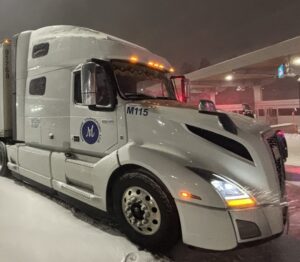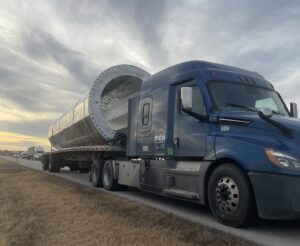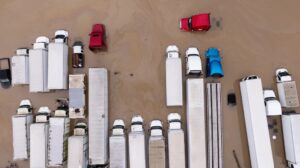You might have noticed a few changes taking place on some of the roadways you’ve traveled. Maybe you’ve encountered a roundabout where there was once an intersection with a stop light. Perhaps a two-lane highway seems wider. Maybe you’ve noticed that more roads have rumble strips along the sides — and some even have them on the center line.
Many of these improvements are the result of efforts by the U.S. Department of Transportation (DOT), the Federal Highway Administration (FHWA) and the FHWA’s National Center for Rural Road Safety in partnership with state, county and local authorities across the country.
An initiative called “Focus on Reducing Rural Roadway Departures (FoRRRwD for short) promotes funding and education for jurisdictions that want to improve highway safety.
On June 30, the group offered a webinar to interested agencies so they could learn what safety treatments are available, how effective they are and where funding might be available.
The presentation started with a stunning statistic: More than 12,000 deaths each year occur on rural roadways due to lane departures, including crossing the center line and running off the road. That number represents about a third of all highway fatalities in a year, even though Interstate highways and city roads handle much more traffic.
The FoRRRwD program is designed to reduce that number, with an ultimate goal of zero fatalities.
The mission of the program is clear: Reduce the potential for serious injury and fatal roadway departure crashes on all public rural roads by increasing the systemic deployment of proven countermeasures.
The program acknowledges that humans make mistakes, a fact that every truck driver sees evidence of every day.
Even though efforts in other areas, such as driver education, vehicle safety systems and even speed limits do have an impact, accidents continue to happen. The FoRRRwD program addresses the roads themselves and how they can be improved to help prevent mistakes or lessen their impact when they occur.
One area where simple improvements can be made to some highways is edge and center line markings. While the benefit of identifying the boundaries of each lane is clear, line markings also help drivers visualize where the road is going. Curves, extra lanes, it’s all visible on the road ahead when the lines are fresh and clear.
Unfortunately, every driver has experienced roadways on which the painted lines have faded, sometimes to the point where they weren’t visible at all. In other cases, a center line may be present but there are no white edge markings.
Painting these lines may not seem like much, but it saves lives.
Using retroreflective pavement markings — those that shine brightly in the glow of headlights — makes the road even safer. These markings can be painted or made from thermoplastic or other materials. There is even guidance to widening the lines to a minimum of 6 to 8 inches for increased effectiveness.
If you’ve noticed the lines in double-yellow center lines seem to be getting farther apart, you did not imagine it. Road crews are creating center line buffer areas on some roads to create a little extra space between oncoming traffic.
Another safety solution that seems obvious is the installation of signs and chevrons to indicate upcoming curves. Signs warn of a curve ahead, which direction the curve goes and, often, an advised speed. Chevrons can be as simple as arrows installed at the road edge that follow the curvature of the road. Devices like these can help drivers perceive how sharp the curve is before it’s too late to slow down. In some cases, flashing lights or speed-warning devices can enhance safety further.
Delineators (small posts with reflective surfaces) can also help drivers perceive road edges. They can provide crucial information where signs haven’t been installed or painted lines may be covered with snow, leaves or dirt.
High friction surface treatments can improve vehicle traction, especially in curves or intersections. The surface treatment is made with a special aggregate that is, in effect, glued to the road surface with a polymer resin.
The treatments can help vehicles stay in their lane when conditions aren’t optimum, such as when the road is wet or when the vehicle is traveling too fast. The treatments help vehicles avoid skids and provide greater steering traction. These surface treatments can wear quickly and must be reapplied periodically but are effective in reducing curve and intersection crashes, especially in wet weather.
Every driver is familiar with rumble strips, but they are being used more often, and on more types of highways than ever. Center line rumble strips have proven effective in preventing head-on collisions, while shoulder rumble strips can help reduce run-off-road crashes. Both warn the driver as soon as a wheel leaves the driving lane.
Everyone has driven on two-lane roads where there is nothing beyond the white side line except dirt, gravel or grass. Often, the ground at the pavement’s edge gets washed away over time, leaving a-drop off or a hole that can pull the vehicle off the road if a steer tire drops into it. That’s why many jurisdictions have adopted shoulder widening as a buffer between motorists and the countryside. A shoulder as small as 2 feet wide provides extra room if a motorist briefly crosses the line, and can make the difference between regaining control and leaving the roadway.
Some of those new shoulders are constructed with a safety edge — an elevated strip of pavement comparable to a small curb on urban roads. This feature can help keep a steer tire from going over the edge, helping the driver stay in control.
Finally, adding features such as guard rails or cable barrier systems can help prevent serious off-the-road crashes. So can taking away fixed objects such as trees and signposts, providing a larger buffer between motorists and objects they could hit. Breakaway signposts are often used when signs can’t be moved farther from the road.
More goes into the design of two-lane roadways than simply laying down pavement and painting lines. FoRRRwD has posted a five-minute video that explains more. A pocket guide is available here.
Cliff Abbott is an experienced commercial vehicle driver and owner-operator who still holds a CDL in his home state of Alabama. In nearly 40 years in trucking, he’s been an instructor and trainer and has managed safety and recruiting operations for several carriers. Having never lost his love of the road, Cliff has written a book and hundreds of songs and has been writing for The Trucker for more than a decade.















